Ijraset Journal For Research in Applied Science and Engineering Technology
- Home / Ijraset
- On This Page
- Abstract
- Introduction
- Conclusion
- References
- Copyright
Phytochemical Analysis & Antibacterial Activity of Oxalis Corniculata
Authors: Mr. Harshal S. Pawar, Mr. Vishal A. Patil, Ms. Yukta D. Patil, Prof. Sameer Shaikh Raees
DOI Link: https://doi.org/10.22214/ijraset.2023.52106
Certificate: View Certificate
Abstract
Phytochemical screening and in-vitro antibacterial activity of the weed plant Oxalis corniculate were carried out to determine its medicinal potential because plants are the primary source of novel medications. Oxalis corniculata Linn. (Family; Oxalidaceae) was tested for antibacterial activity against three important bacteria E. coli, Salmonella Typhi, S.Aureus. Powdered leaf material was extracted with different solvents viz., water and alcohol using Soxhlet apparatus. All the solvent extracts were evaporated to dryness using sun drying. Dry residue was dissolved in respective solvents and tested for antibacterial activity The antibacterial activity was investigated using the agar well diffusion method.
Introduction
I. INTRODUCTION
This project work was based on Phytochemical Analysis and Antibacterial Activity of Oxalis corniculata; A Known Medicinal Plant.
A. What are Phytochemicals?
The substances found naturally in plants are known as phytochemicals. Nowadays, these phytochemicals are increasingly well-known because of all the different medical applications they have. Phytochemicals are essential in the fight against several diseases, including cancer, arthritis, and asthma. These phytochemicals do not have any side effects, in contrast to pharmaceutical compounds. As phytochemicals treat illnesses without endangering people, they can also be referred to as "man-friendly medications."
The atmosphere's level of oxygen is significantly maintained by plants. Some plants are used for their medical benefits, some for decoration, and yet others are used to make natural dyes. Ayurveda's foundation is based on plants. Both Ayurveda and homoeopathic treatment highly depend on plant extracts. As a result, plants are produced for their therapeutic qualities. There are numerous plants that survive on their own and with other plants with little care. Oxalis Corniculata is an example of this kind of plant. The oxalidaceae family includes the annual plant Oxalis corniculata. It is a herb that is not usually consumed because people are not aware of its medical benefit. [1]
It has been reported that the plant is a creeper. It may grow in both temperate and tropical climates. It can frequently be seen in hedges, gardens, etc. The herb has numerous significant medical benefits, including as antibacterial activity and treatment of pimples, burns, and cutaneous eruptions. Warts and corns can be removed with its help. The herb is therefore widely known for its curative properties. It also goes by the name of creeping sorrel. [2]
More than 80% of people worldwide rely on conventional medicine for their main healthcare requirements, according to the World Health Organization (WHO). Over the world, health services have benefited greatly by using plants as a source of medicine globally, the use of herbal medicines reflects a long history of environmental interactions between people and the environment. Many substances found in plants used in traditional medicine can be used to treat both viral and chronic ailments. The human body is extremely susceptible to bacterial, viral, and fungal diseases. Early in the 20th century, antibiotics were discovered, and they have since become a vital tool in the fight against bacterial illnesses.
Yet multiple drug resistance has emerged as a result of the careless use of commercial antimicrobial medications that are frequently used to treat infectious infections. [2,3] Aside from this issue, antibiotics can also occasionally have negative consequences on the body, such as hypersensitivity, immune system suppression, and allergic reactions.[4] As a result, there is a demand for innovative, safe, and efficient antimicrobial therapeutics. In this context, naturally occurring medicinal plants with active components that exhibit antibacterial action may offer a large research area. The medicinal potential of antimicrobials derived from plants is immense. While concurrently minimising many of the negative effects sometimes connected with synthetic antimicrobials, they are efficient in the treatment of infectious infections.
People who have infections brought on by drug-resistant bacteria have a higher risk of having worse clinical outcomes, dying, and using up more medical resources than patients who have infections brought on by non-resistant strains of the same bacteria. Fluoroquinolone antibiotics, one of the most often prescribed medications for the treatment of urinary tract infections, are very commonly resistant to E. coli. More than half of patients receiving this medication are no longer responding in several nations throughout the world. [5,6]
The objective of this project is:
- The plant Oxalis corniculata was collected from different places in and around shahada (M.H.) India.
- The collected plant was identified at Department of Botany, Poojya Sane Guruji Vidya Prasarak Mandals A.S.C. Shahada, India.
- Extraction of leaves
- Phytochemical analysis.
- Antibacterial activity of leaves extract
II. DESCRIPTION OF OXALIS CORNICULATA.
A. Morphological Information
In its growth locations, Oxalis corniculata forms a mat-like structure and is bushy in nature. The plants' tops are weakly erected, smooth or bushy. They have nodes at which they are rooted and branch out from there.[7]
- Leaves: The trifoliate, slender, and heart-shaped leaves of the plants are shown in Figure 2 as leaves. The apical indentation of the leaflets is distinct. The leaves are placed alternately along the stem, and the leaflets feature reticulate venation.[7]
- STEM: The plant's stem is slender in shape and coated with fine, short hairs. The internodes range in length from 5 to 9 cm. It tastes sour and has an acidic odor.[8]
- Root: The root is dark brownish, thin, branched, soft; with no odour and taste.
- Flowers: The flowers are 6-12 mm wide and have 5 yellow petals. [7]
- Fruits: The fruits are a capsule, 1-1.5 cm long, cylindrical, pointed and ridged.[18]
- Seeds: The seeds are oval in outline, rounded, basally pointed, flattened, light brown and have a surface distinctly ridged. It has stolon’s also.[7]
B. Taxonomical Classification [14]
Kingdom: Plantae
Division: Magnoliophyta
Class: Magnoliopsida
Order: Oxalidales
Family: Oxalidaceae
Genus: Oxalis
Species: corniculata
Botanical Name: Oxalis corniculata Linn.
Vernacular Names [14]
Telegu- Ambotikura; Bengali- Amrul Shak; AssameseChangeritenga; English- Indian sorrel; Oriya- Sialthur; HindiKhatari; Arabic- Hememdab; Tamil- Puliakire; KannadaJulihunise gida; Malyalam- Puliyarila; Marathi- Bhinsarpati; Sanskrit- Shuklika
- Ethnomedicinal Uses
There are numerous traditional uses for oxalis corniculata as a medicine. It is used in a Nepal village for digestive and liver issues. The leaf paste is applied to the forehead to treat headaches. To halt bleeding from cuts, crushed leaves are utilized. The Assamese Boro tribal people use the plant's juice as an eye drop to treat conjunctivitis. Butter milk is used with boiling plant parts for digestion and diarrhea. It is also a wonderful appetizer because it treats anemia, dyspepsia, piles, kapa, and vata. It treats skin conditions like warts, corns, and edema. When a snake bite occurs, Zairians apply a salted plant paste made with Aframomum sanguine to the entire biting region. Moreover, it serves as an anti-venom. The plant's leaf extract is combined with castor oil and consumed as a home treatment for insomnia to promote restful sleep. [16] The plant's leaves are also used to make a decoction that is administered to the eyes to soothe itchy eyelids and to clear up corneal opacities.
In addition to being used as a gurgle, leaves are also used as an antidote for poisoning caused by Datura seeds, arsenic, or mercury. To treat burns, skin outbreaks, and bug bites, the leaves' sup is used. When treating scurvy, the entire plant is utilized as an anti-scorbutic. In Madhya Pradesh the leaf decoction is used in fever and dysentery.
C. Phytochemical Components
Previous research has isolated a variety of phytochemical components from this medicinal herb, including tannins, flavonoids, polyphenols, steroids, alkaloids, volatile oils, fatty acids, glycosides, etc. This plant has been found to contain essential fatty acids including palmitic acid, linoleic acid, linolenic acid, stearic acid, and oleic acid in previous research. The main source of vitexine-2-0-beta-D-glucopyrunoside and vitexine is the plant's leaves. Previous studies have found that the plant's methanolic and ethanolic extracts include carbohydrates, proteins, amino acids, fibre, and calcium. Citric and tartaric acids are abundant in the stem and leaves, and malic acid is also present there. Carotene and vitamin C are also present in plant tissues. Oxalates are more abundant, and acidic phytocompounds give the leaves and stem an acidic flavour. These plant's leaves contain vanillic. In addition, it has 86 % water, 0.8% fat, 8.2% carbohydrates, 150 mg calcium, 78 mg phosphorus, 8 mg iron, 0.6 mg niacin, 78 mg vitamin C, and 6050 g beta carotene. The oxalate content ranges from 7 to 12 percent.
- Constituents: The herb's leaf has a significant moisture concentration. It is a good source of crude lipid, crude protein, and carbohydrates. Moreover, it has the following mineral nutrients: Magnesium (0.25+0.03%), Sodium (1.12+0.02%), Potassium (2.17+0.31%), Calcium (2.51+ 0.08%), and Nitrogen (3.561+0.70%). As a result, it can be a valuable alternative vegetable.
D. Pharmacological Properties
Wound Healing Property, Anti-diarrheal Property, Anti-cancer Property, Anti-implantation and Abortifacient Property, Anti-Diabetic Property, Anti Inflammatory Property, Anti-ulcer Property, Anti-Epileptic Property, Hypolipidemic Property, Toxicological Examinations,
Antibacterial activity
- What is Antibacterial activity?
A substance known as an antimicrobial is one that either eliminates bacteria (a microbicide) or inhibits their growth (a bacteriostatic agent). The primary bacteria that antimicrobial medications operate against can be categorised. Antibiotics, for instance, are used to treat bacterial infections whereas antifungals are used to treat fungal infections. The function they serve can also be used to classify them. Antimicrobial chemotherapy is the term used to describe the use of antibiotics to treat an infection, whereas antimicrobial prophylaxis refers to the administration of antibiotics to avoid infection. Since at least 2000 years ago, people have been using antibiotics frequently. Ancient Greeks and Egyptians both utilised particular moulds and plant extracts to heal infections.
III. MATERIALS AND METHODS
- General Techniques Involved in Phytochemical Analysis
- Collection of plant material
Healthy, disease free, mature leaves of Oxalis corniculata collected from from different places in and around shahada (M.H.) India.were used for the preparation of aqueous and different solvent extracts. A voucher specimen of the plant has been deposited in the herbarium of Department of Studies in Botany, Poojya Sane Guruji Vidya Prasarak Mnandal’s A.S.C. College Shahada.
Plants under consideration may be collected either from wild forests or from herbariums. When plants are collected from wild, there is a risk that they have been incorrectly identified. The major advantage of wildlife plants is that they will not contain any pesticides. After the plants are collected from wild or from herbarium, they have to be processed for cleaning in order to prevent the deterioration of phytochemicals present in plants.
1. Cleaning of Plants
After plants collection they have to be cleaned properly. The cleaning process may involve the following steps. Cleaning, washing, peeling or stripping leaves from stems. Cleaning has to be done by hands in order to get better results.
2. Drying
The main purpose of drying is to remove the water content from plants so that the palnts can be stored. Plants have to be dried immediately as soon as the plants collection or this will lead to spoilage of plant materials. The drying consists of two methods. Drying can be done either by natural process or by artificial process.
a. Natural Process: Natural process includes sun- drying. Sometimes plants are placed on drying frames or on stands, to be air-dried in barns or sheds. But this may take few weeks for complete drying. The time depends on temperature and humidity.
b. Artificial Drying: Artificial drying can be done with the help of artificial driers. This process will reduce the drying time to several hours or minutes. The common method that is followed in drying medicinal plants is warm-air drying. In this process plants are placed in the plates of drier on which warm air is blown. This method is mainly applicable to fragile flower and leaves and this requires large number of workers since loading and unloading of plants has to be done manually.
3. Powdering
After complete drying of plants, they have to be powdered well for further analysiI.
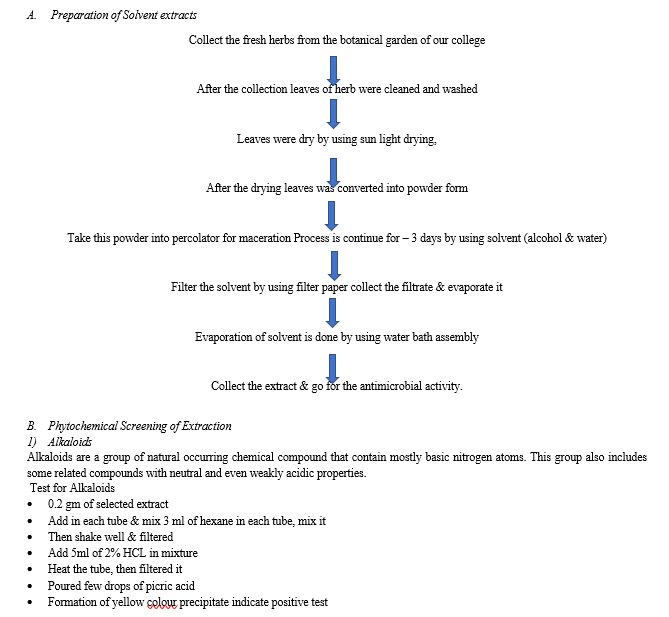
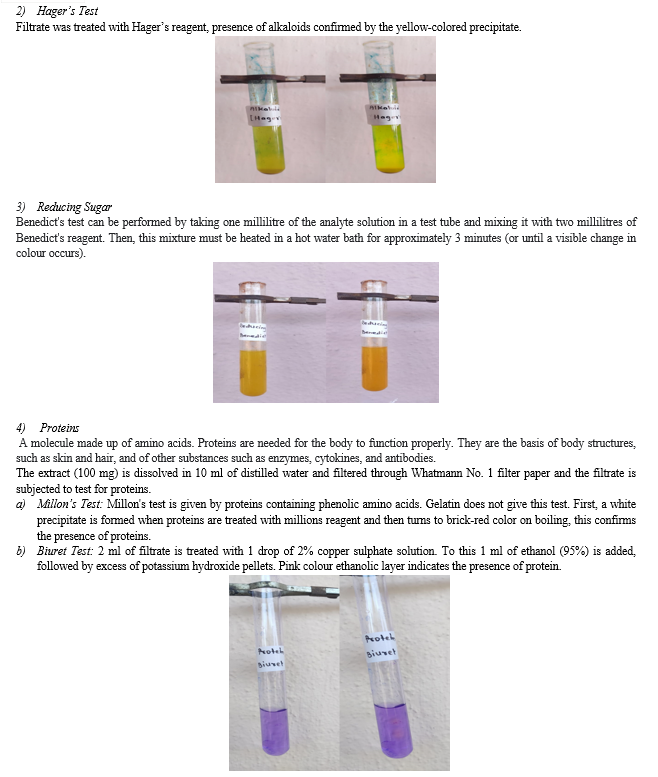
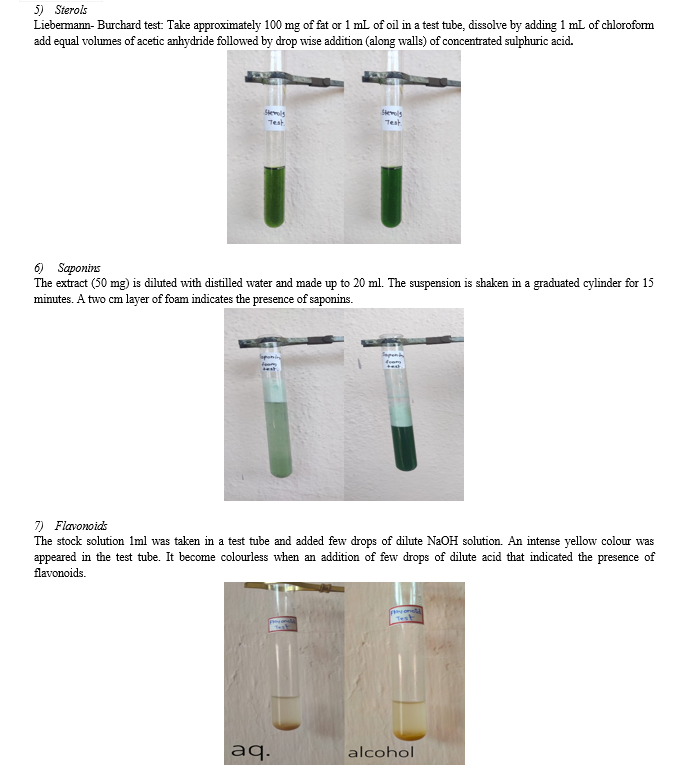
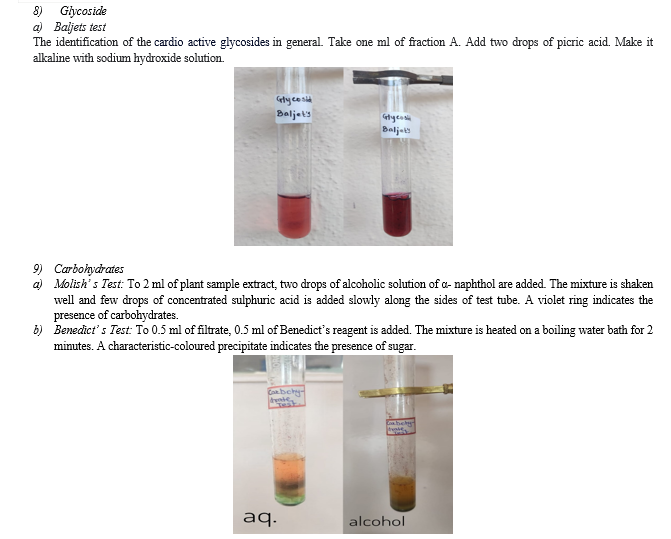
- Microbial strains: Salmonella Typhi, E. coli, S. Aureus.
- Standard reference antibiotic: Erythromycin
- Preparation of broth culture: For the preparation of broth culture for bacteria, the liquid media was prepared as per given composition for broth culture. After the sterilization of media, the bacterial strains were inoculated under laminar air flow. The incubation of inoculated media was carried out at 37? for 48 hours.
- Preparation and sterilization of media [24]: The nutrient agar was taken in 500ml conical flask which is plugged with non-absorbent cotton plugs and kept in autoclave (121?, 15lbs pressure) to sterilize the media for an hour.
- Plating the media: Molten media was poured on to the Petri dish (presterilized in oven for 2 hours at 20? in order to avoid contamination). The plated Petri dishes were kept on a plane surface to avoid non-uniform solidification of medium. All these options were performed on a sterile room which was fitted with laminar air flow.
- Bacterial culture preparations: Bacterial cultures were inoculated in the freshly prepared nutrient broth (which are prepared prior and sterilized) and kept on rotary shaker for 24 hours and observed for growth (turbidity indicates the growth).one day old cultures are used for testing and determination of each extract.
C. Method of Preparation of Agar Medium
- Begin making the TSB (broth) by pouring 250ml of distilled water into a 500ml or 1L flask. Put in the stir bar and turn on the stir plate so that the surface is just disturbed. Add 3.25 grams of the TSB powder to this flask and allow it to dissolve (will happen quickly). No heat need be applied at this stage.
- Once the powder is dissolved, pipet out 5ml green cap.
- With the remaining solution (about 100ml) still stirring, add 2 grams of agar powder.
- The next step will require you to apply heat to the mixture. Before you do this, however, you should be aware that agar has a strong tendency to boil over when it reaches 100?C. Someone in your group should be watching the flask at all times once you see steam coming off of it. At the first sign that the mix is near boiling, remove it from the hot plate (paper towels around the flask neck). do not simply turn off the heat, letting the flask sit there. The metal plate retains a significant amount of heat, and turning off the heat will not prevent the flask from boiling over. Folded paper towels allow you to grasp the flask neck tightly, yet not burn your hand.[27]
- Have you read step 4? OK, then you can turn on the heat to setting 9 (not High). Make sure that the magnetic bar is stirring the solution.
- Upon boiling, the agar dissolves, it will turn clear, deeper tan. Remove it from the heat and pipet out 5ml aliquots into 15 tubes for slants (will not be BE slants until removed from autoclave and tilted to the side to solidify). Cover the slant tubes with yellow caps.[28]
Assay of antibacterial activity of the plant extract by Agar well diffusion method
Agar well diffusion method is widely used to evaluate the antimicrobial activity of plants or microbial extracts. The agar plate surface is inoculated by spreading a volume of the microbial inoculum over the entire agar surface. Then, a hole with a diameter of 6 to 8 mm is punched aseptically with a sterile cork borer or a tip, and a volume (20–100 µL) of the antimicrobial agent or extract solution at desired concentration is introduced into the well. Then, agar plates are incubated under suitable conditions depending upon the test microorganism. The antimicrobial agent diffuses in the agar medium and inhibits the growth of the microbial strain tested [21] All plate were incubated at 37?c for 24hrs. The plates were then examined for zones of inhibition after the 24hrs incubation period. The zones were examined and were recorded in millimetres.
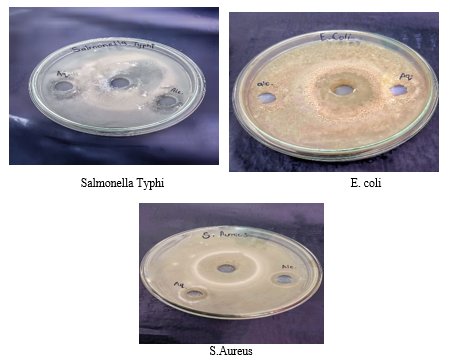
IV. RESULT
The results of the phytochemical screening revealed the presence of carbohydrates, reducing sugar, proteins, sterols, acidic compounds, alkaloids, tannins, phenolic compounds, flavonoids, cardiac glycosides in both aqueous and methanol extract of the plant. Saponins and Resins are not detected in the tests.
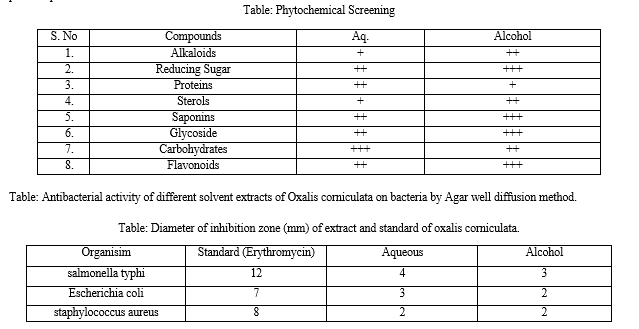
Conclusion
There is a continuous and urgent need to discover new antimicrobial compounds with diverse chemical structures and novel mechanisms of action because there has been an alarming increase in the incidence of new and re-emerging infectious diseases. Another big concern is the development of resistance to the antibiotics in current clinical use. Some of the pathogens rapidly become resistant to many of the first discovered effective drugs. The development of drug resistance as well as appearance of undesirable side effects of certain antibiotics (WHO, 2002) has led to the search of new antimicrobial agents in particular from medicinal plants. This study is substantial step and further in-depth research is required to isolate the bioactive compounds of this species as well as further studies on its bio efficiency against human pathogens. Also, there is need to study the mechanism of action of and the toxicity level of the plan.
References
[1] The Ayurvedic Pharmacopoeia of India, Part-I. Vol. 3. New Delhi: Department of AYUSH, Ministry of Health and Family Welfare, Government of India, 2001; 36-8. [2] M. Srikanth, T. Swetha and B. Veeresh, “Phytochemistry and pharmacology of oxalis corniculata linn.: a review.” IJPSR., 2012; 3(11): 4077-4085. [3] D. D. Tibuhwa, “Oxalis corniculata L. in Tanzania: traditional use, cytotoxicity and antimicrobial activities.” Journal of Applied Biosciences, 2016; 105: 10055 –10063. [4] Jain, T. Tiwari and M. Bashir, “Nutritive Aspects of Oxalis corniculata Linn. used by Tribals of Central India During Scarcity of Food”. Botany Research International, 2010;3(1): 35-37. [5] V. Singh, N. Shah and D. K. Rana, “Medicinal importance of unexploited vegetable under North Eastern regions of India”. Journal of Medicinal Plants Studies, 2015; 3(3):33-36. [6] R. A. Sharma and A. Kumari, “Phytochemistry, pharmacology and therapeutic application of oxalis corniculata linn. - a review”. Int J Pharm Pharm Sci., 2014; 3: 6-12. [7] Hall DW, Vernon VV, Brent A. Sellers. Creeping Wood Sorrel, Oxalis corniculata L. Southern Yellow Wood Sorrel, Oxalis florida Salisb. SP 37, Florida Cooperative Extension Service, Institute of Food and Agricultural Sciences, University of Florida,1996, 01-02. [8] Saha S. Oxalis corniculata Linn. (Amrul): Magical plant. American International Journal of Research in Formal, Applied & natural sciences. 2017; 18(1):16-19. [9] Hioki M, Kaori T, Yokotani Kunijiro Y. Flavanoids in the leaves of Oxalis Corniculata and sequestration of the flavanoids in the wing scales of the pale grass blue butterfly Pseudozizeeria maha. Journal of plant research. 2008; 121:133-136. [10] Jain A, Tiwari P, Bashir M. Nutritive Aspects of Oxalis corniculata Linn. used by Tribals of Central India During Scarcity of Food. Botany Research International. 2010;3(1):35-37. [11] Watcho P, Nkouathio E, Telesphore B, Nguelefack SW, Albert Kamanyi. Anti diarrhoeal activity of aqueous and methanolic extracts of Oxalis corniculata klotzch. in rats. Cameroon Journal of experimental Biology. 2005; 01:6-49. [12] Jyothi KSN, Hemadatha P, Suresh Schalla. Evaluation of ?-amylase inhibitory potential of three medicinally important traditional wild food plants in India. International Journal of green pharmacy, 2011, 95-99. [13] Kathiriya A, Das K, Kumar EP, Mathai KB. Evaluation of antitumor and antioxidant activity of Oxalis corniculata linn. Against Ehrlich ascites carcinoma on mice. Iranian journal of cancer prevention. 2010; 4:157-165. [14] Badwaik H, Singh MK, Thakur D. The Botany,Chemistry, Pharmacological and Therapeutic Application of Oxalis corniculata Linn. - a review. International Journal of Phytomedicine. 2011; 3:01-08. [15] Mary Z, Vasantha KKG, Pasupathy S, Bikshapathi T.Pharmacognostical studies on changeri Oxalis corniculata Linn. (Oxalidaceae):Ancient Science of Life 2001; 21(2):1-8. [16] Hebbar SS, Harsha VH, Shripati V, Hedge GR. Ethnomedicine of Dharwad district in Karnataka, India. Journal of Ethnopharmacology. 2004, 94:261-266. [17] Badwaik H, Singh MK, Thakur D. The Botany, Chemistry, Pharmacological and Therapeutic Application of Oxalis corniculata Linn. - a review. International Journal of Phytomedicine. 2011; 3:01-08. [18] Mary Z, Vasantha KKG, Pasupathy S, Bikshapathi T. Pharmacognostical studies on changeri Oxalis corniculata Linn. (Oxalidaceae):Ancient Science of Life 2001; 21(2):18. [19] Hall DW, Vernon VV, Brent A. Sellers. Creeping Wood Sorrel, Oxalis corniculata L. Southern Yellow Wood Sorrel, Oxalis florida Salisb. SP 37, Florida Cooperative Extension Service, Institute of Food and Agricultural Sciences, University of Florida,1996, 01-02. [20] Hioki M, Kaori T, Yokotani Kunijiro Y. Flavanoids in the leaves of Oxalis Corniculata and sequestration of the flavanoids in the wing scales of the pale grass blue butterfly Pseudozizeeria maha. Journal of plant research. 2008; 121:133-136. [21] Valgas C., De Souza S.M., Smânia E.F.A. Screening methods to determine antibacterial activity of natural products. Braz. J. Microbiol. 2007;38:369–380. [Google Scholar] [22] Abinash, P.S., Venkat, K.R., Peasta, S., Prenab, G., and Utpal, B., 2006. Ethnobotany of medicinal plants used by Assamease people for various skin alimments and cosmetics, Journal of Ethnopharmacology, 106, 149-157. [23] Achola KJ, Mwangi JW, Munenge RW, 1996. Pharmacological activity of oxalis corniculata, Pharmaceutical Biology, 33 (3), 247-249. [24] Ali M. Text book of Pharmacognosy. 2nd edition. CBS Publication, New Dehli, 1998; 52 -68p. [25] Ameenah, Q.F., Mala, S., Joseph, G., and Ehian, D., 1993. Medical Ethnobotany of some weeds of Mauritius and Rodrigues, Journal of Ethnopharmacology, 39, 175-185. [26] Danie,l M., 2006. Medicinal Plants: Chemistry and Properties.Science Publishers, Enfield, pp. 210. [27] Farnsworth, N.R., Akerele, O., Bingel, A.S., 1985. Medicinal Plants in Therapy. Bull WHO, 63, 965-981. [28] 28.Farombi, E. O. 2003. African indigenous plants with chemo therapeutic potentials and biotechnological approach to the production of bioactive prophylactic agents. African J. Biotech, 2: 662 – 671. [29] Han, S.T., 1998. Medicinal plants in the South Pacific. WHO Regional Publications, Western specific series no. 19, pp. 135.Harborne
Copyright
Copyright © 2023 Mr. Harshal S. Pawar, Mr. Vishal A. Patil, Ms. Yukta D. Patil, Prof. Sameer Shaikh Raees. This is an open access article distributed under the Creative Commons Attribution License, which permits unrestricted use, distribution, and reproduction in any medium, provided the original work is properly cited.

Download Paper
Paper Id : IJRASET52106
Publish Date : 2023-05-12
ISSN : 2321-9653
Publisher Name : IJRASET
DOI Link : Click Here
 Submit Paper Online
Submit Paper Online

